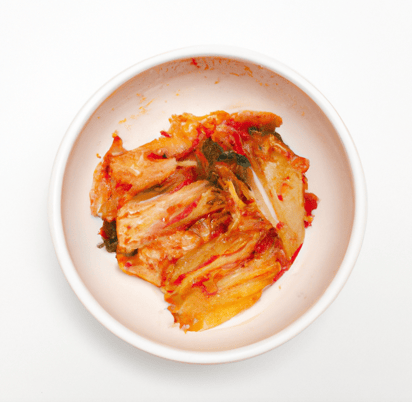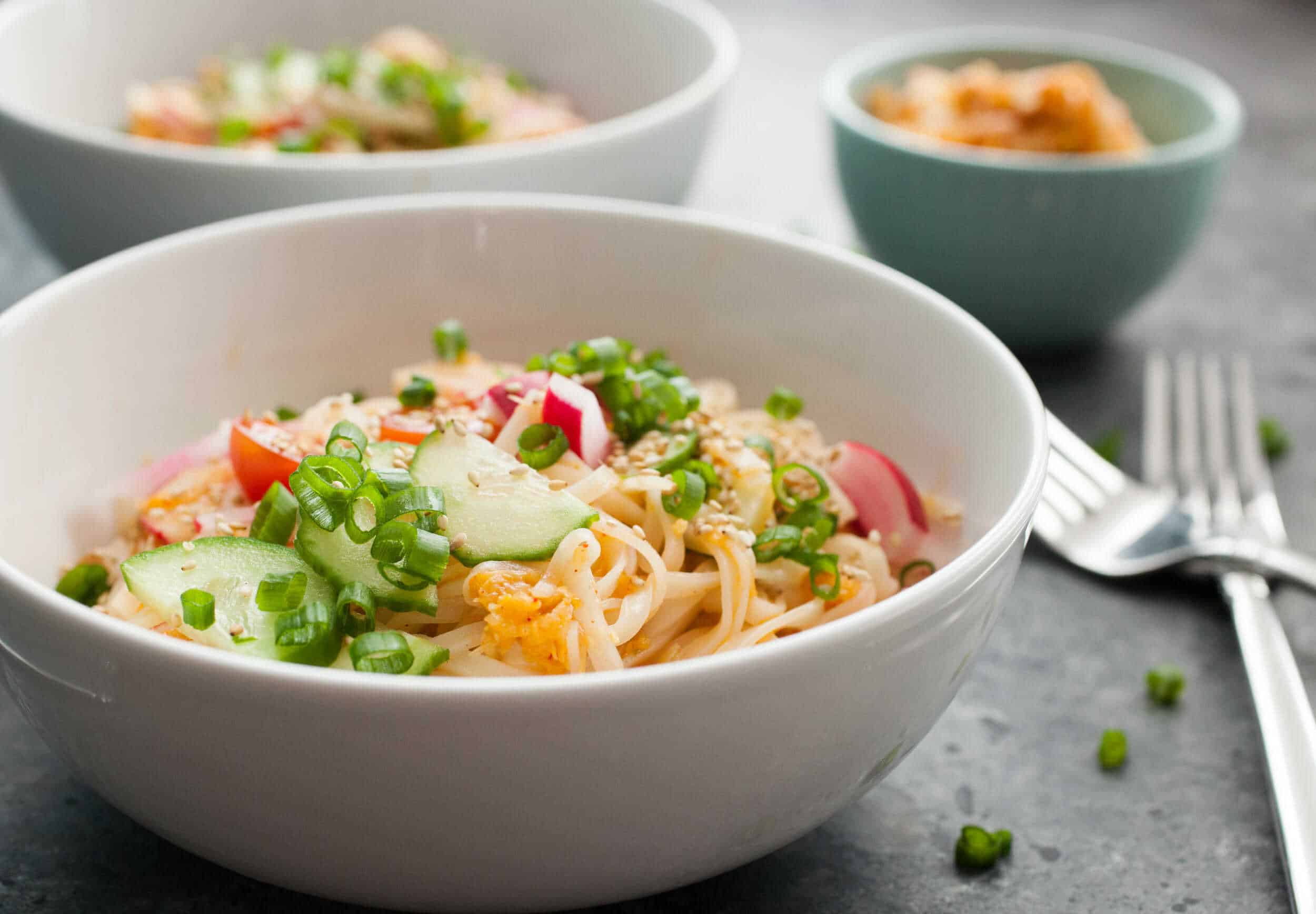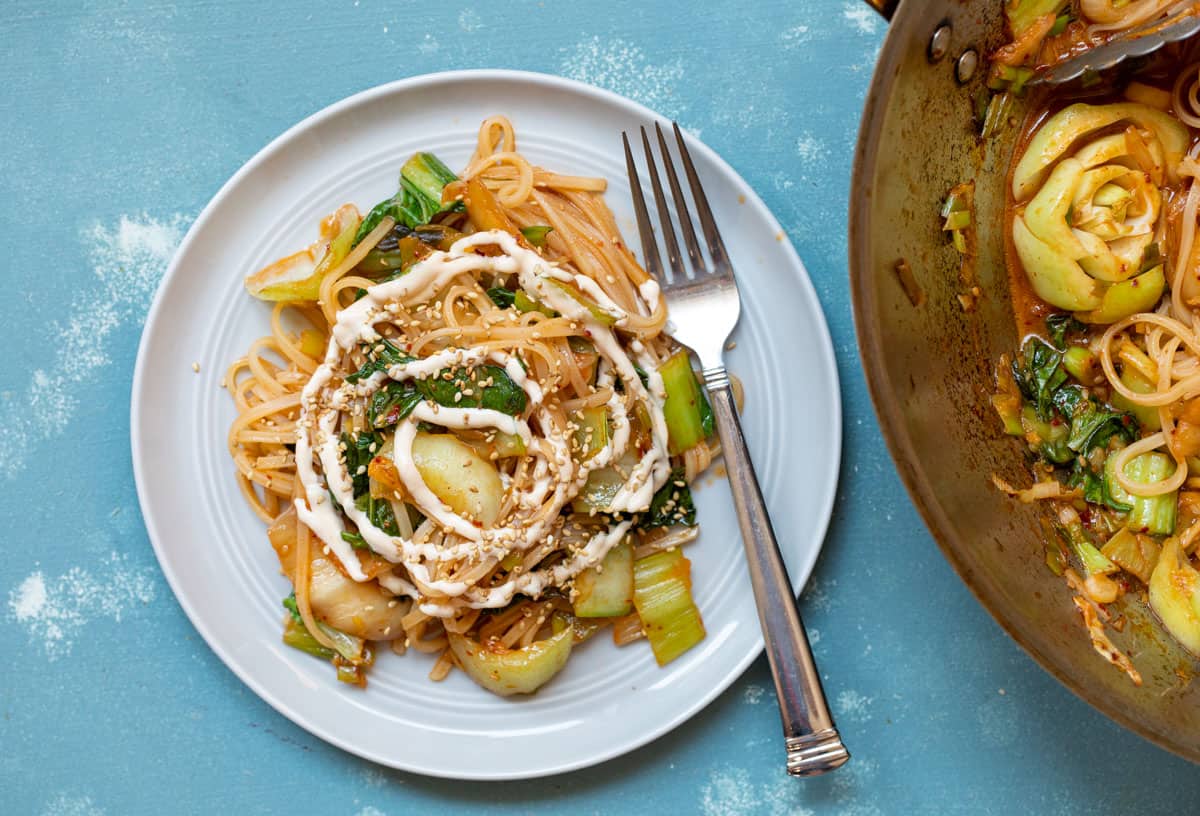Kimchi: Important Facts, Health Benefits, and Recipes
Explore the origins, health benefits, and culinary uses of kimchi, the popular Korean fermented dish, and learn how to incorporate it into your daily meals.

Nutritional Facts
1 cup
Amount per serving
Calories
22.5
Carbohydrates
3.6 g
Fat
0.8 g
Protein
1.6 g
Saturated Fat
0.1 g
Sodium
747 mg
Fiber
2.4 g
Sugar
1.6 g
Best Kimchi Recipes
-

-

-

-

-

-

-

-

-
![Healthy Korean Beef Bowls: Image]()
-
![Steak Kimchi Fried Rice Image]()
-
![Korean Beef Skewers Recipe Image]()
-
![Kimchi Deviled Eggs Recipe Image]()
-
![Hot Dogs with Spicy Kimchi Slaw Recipe Image]()
-
![Bibimbap with Bacon and Kimchi Recipe Image]()
-
![Dinner Tonight: Kimchi Soup with Tofu and Spinach Recipe Image]()
-
![Dinner Tonight: Cold Sesame Noodles with Kimchi Recipe Image]()
-
![Dinner Tonight: Seared Pork Chops with Kimchi Recipe Image]()
-
![Squash, Shiitake, Kale, and Kimchi Stew Recipe Image]()
-
![<i>Doenjang Jjigae</i> (Korean Fermented-Bean-Paste Stew) Recipe Image]()
-
![DIY Spicy Kimchi Beef Instant Noodles Recipe Image]()
-
![Grilled Cheese With Kimchi Recipe Image]()
-
![Kimchi and Asparagus Stir-Fry With Spam and Fried Egg Recipe Image]()
-
![Kimchi Chicken and Cabbage Stir-Fry Recipe Image]()
-
![Kimchi-Brined Fried Chicken Sandwich Recipe Image]()
-
![Kimchi Fried Rice with Sautéed Squid and a Poached Egg Recipe Image]()
-
![Kimchi Pasta with Bacon and Sesame Seeds Recipe Image]()
-
![Korean Spicy Marinated Pork With Chilies and Kimchi (Jaeyook Kimchi Bokum) Recipe Image]()
-
![Dinner Tonight: Korean Barbecue Beef Bulgogi Recipe Image]()
-
![Korean Kimchi Barbecue Sauce Recipe Image]()
-
![Korean Scallion Pancake with Shrimp, Bacon, and Kimchi Recipe Image]()
-
![Kimchi and Spam Fried Rice Recipe Image]()
-
![Mayo-Free Chicken Salad With Kimchi, Ginger, and Scallions Recipe Image]()
-
![Grilled Korean Bulgogi Burgers With Kimchi Mayo and Pickled Daikon Recipe Image]()
-
![Korean Beef Bulgogi Burritos Recipe Image]()
-
![Seriously Asian: Naengmyeon, Korean Cold Noodles Recipe Image]()
-
![Quick Kimchi Ramen With Shiitake Mushrooms and Soft-Cooked Egg Recipe Image]()
-
![Roasted Brussels Sprouts With Kimchi and Ginger Recipe Image]()
-
![Easy Sichuan Dry-Fried Green Beans (Gan Bian Si Ji Dou) Without a Wok Recipe Image]()
-
![Seriously Asian: Korean Soondubu Jjigae (Soft Tofu Stew) Recipe Image]()
-
![Soondubu Jjigae (Korean Soft Tofu Stew) Recipe Image]()
-
![Sweet Barbecue Kim-cheese Burgers Recipe Image]()
-
![Trotters and Hocks Bo Ssam Recipe Image]()
-
![Korean Ground Beef Bowls Image]()
-
![Spicy Kimchi and Natto (Fermented Soy Bean) Recipe Image]()
-
![Korean Kimchi Pancakes Recipe Image]()
-
![Easy Kimchi (or Kimchee) Rice Cooker Recipe Image]()
-
![Recipe for Budae Chigae or Korean Army Base Stew Image]()
-
![Cheesy Kimchi Dip, Hawaiian Style Reciipe Image]()




:max_bytes(150000):strip_icc()/__opt__aboutcom__coeus__resources__content_migration__simply_recipes__uploads__2016__07__2016-07-11-Beef-Skewers-5-b86b77996c8d4ed98c47661fbbe90f28.jpg)
:max_bytes(150000):strip_icc()/__opt__aboutcom__coeus__resources__content_migration__simply_recipes__uploads__2018__06__Kimchi-Deviled-Eggs-LEAD-HORIZONTAL-5d81fcb279c74c22b3d6e6ec13f5cc32.jpg)
:max_bytes(150000):strip_icc()/__opt__aboutcom__coeus__resources__content_migration__simply_recipes__uploads__2018__06__Hot-Dogs-Kimchi-LEAD1-dd10e3b0fa604734833bdd4a432c1bc5.jpg)
/__opt__aboutcom__coeus__resources__content_migration__serious_eats__seriouseats.com__recipes__images__2013__03__20130318-245123-dinner-tonight-bibimbap-bacon-kimchi-spinach-2-primary-2e99d1b21be44c5daee6f682051fb5e7.jpg)



:max_bytes(150000):strip_icc()/__opt__aboutcom__coeus__resources__content_migration__serious_eats__seriouseats.com__recipes__images__2013__09__20130909-266084-dinner-tonight-vegetable-kimchi-stew-primary-3f1902ba0aa04cbe8e51245f47535a9d.jpg)
:max_bytes(150000):strip_icc()/__opt__aboutcom__coeus__resources__content_migration__serious_eats__seriouseats.com__2018__11__20181102-doenjang-jjigae-vicky-wasik-10-8fbe8600e58c4b2d95095d5ab3098885.jpg)
:max_bytes(150000):strip_icc()/__opt__aboutcom__coeus__resources__content_migration__serious_eats__seriouseats.com__recipes__images__2014__09__20140929-instant-noodles-diy-recipe-kimchi-beef-15-c763d570b1434ba7b887f52d44f75525.jpg)
:max_bytes(150000):strip_icc()/__opt__aboutcom__coeus__resources__content_migration__serious_eats__seriouseats.com__recipes__images__2015__02__20150219-grilled-cheese-kimchi-sandwich-vicky-wasik-1-537c5f758ac748049460e78e87730098.jpg)
:max_bytes(150000):strip_icc()/__opt__aboutcom__coeus__resources__content_migration__serious_eats__seriouseats.com__2018__04__20180405-asparagus-alla-milanese-variations-vicky-wasik-14-2d6b022f834c408689d596baac76b98b.jpg)
:max_bytes(150000):strip_icc()/__opt__aboutcom__coeus__resources__content_migration__serious_eats__seriouseats.com__recipes__images__2014__03__20140227-kimchi-chicken-primary-73becf12f8374b59b22dab5cefbb17be.jpg)
:max_bytes(150000):strip_icc()/20181218-kimchi-fried-chicken-sandwich-vicky-wasik-07-05f214a163684dc9b7ccb07ae3a70154.jpg)

:max_bytes(150000):strip_icc()/__opt__aboutcom__coeus__resources__content_migration__serious_eats__seriouseats.com__recipes__images__20120112-187577-dinner-tonight-kimchi-pasta-bacon-sesame-primary-8e509feeb78c4e5088508983cea1174e.jpg)
:max_bytes(150000):strip_icc()/__opt__aboutcom__coeus__resources__content_migration__serious_eats__seriouseats.com__recipes__images__2014__09__20140912-korean-pork-kimchi-daniel-gritzer-9-9f5e96802ea74781a9a8386c0858c750.jpg)
:max_bytes(150000):strip_icc()/__opt__aboutcom__coeus__resources__content_migration__serious_eats__seriouseats.com__recipes__images__dt-bulgogi-57983230adab4c768bdb892929cb9814.jpg)
:max_bytes(150000):strip_icc()/__opt__aboutcom__coeus__resources__content_migration__serious_eats__seriouseats.com__recipes__images__2015__06__20150604-barbecue-sauce-daniel-gritzer-36-7e656f2f831d4fc480d60ef3d52e3bb4.jpg)
:max_bytes(150000):strip_icc()/__opt__aboutcom__coeus__resources__content_migration__serious_eats__seriouseats.com__recipes__images__2012__10__201201008-224897-dinner-tonight-korean-pancake-bacon-shrimp-kimchi-primary-1642a57617a74bea859f1349456a65e0.jpg)
:max_bytes(150000):strip_icc()/__opt__aboutcom__coeus__resources__content_migration__serious_eats__seriouseats.com__recipes__images__2016__03__20160403-spam-kimchi-fried-rice-21-ea4ab61a2c5a4813846fac0c6755d6e6.jpg)
:max_bytes(150000):strip_icc()/__opt__aboutcom__coeus__resources__content_migration__serious_eats__seriouseats.com__recipes__images__2015__01__20141205-korean-chicken-salad-vicky-wasik-4-9aa3fd813ecc4a9b99abbdb9883facb0.jpg)
:max_bytes(150000):strip_icc()/__opt__aboutcom__coeus__resources__content_migration__serious_eats__seriouseats.com__recipes__images__2017__06__20170617-bulgogi-burger-matt-clifton-1-b9769887cb1e4a4a8d9e9922bbabcace.jpg)
:max_bytes(150000):strip_icc()/__opt__aboutcom__coeus__resources__content_migration__serious_eats__seriouseats.com__recipes__images__2017__03__20170210-korean-bulgogi-emily-matt-clifton-3-9de680d9abb84e11bb8c05fd1b8612b4.jpg)
/__opt__aboutcom__coeus__resources__content_migration__serious_eats__seriouseats.com__recipes__images__20100604-seasian-primary-c869e22a0211493c92ca3debc383201e.jpg)
:max_bytes(150000):strip_icc()/__opt__aboutcom__coeus__resources__content_migration__serious_eats__seriouseats.com__recipes__images__2014__10__20141007-quick-kimchi-ramen-daniel-gritzer14-ab70850477554808ab3f70b4eff8904e.jpg)
:max_bytes(150000):strip_icc()/__opt__aboutcom__coeus__resources__content_migration__serious_eats__seriouseats.com__recipes__images__2015__10__20151019-brussels-sprouts-kimchi-roast-recipe-8-kenji-8c2a1ecd9c8244d3b998210e3a5e7230.jpg)
:max_bytes(150000):strip_icc()/__opt__aboutcom__coeus__resources__content_migration__serious_eats__seriouseats.com__recipes__images__2015__03__20150305-sichuan-dry-fried-green-bean-broiled-food-lab-13-cb9fd41bcc024cffb98b44629a5e8b63.jpg)
:max_bytes(150000):strip_icc()/__opt__aboutcom__coeus__resources__content_migration__serious_eats__seriouseats.com__recipes__images__20091030-soondubu-thumb-8e84c1296a6d45d2a22e26e1d1f7663a.jpg)
:max_bytes(150000):strip_icc()/__opt__aboutcom__coeus__resources__content_migration__serious_eats__seriouseats.com__recipes__images__2012__02__20120206-tofu-detail-1c849a32f8c44855af7c14a2e30a8168.jpeg)
:max_bytes(150000):strip_icc()/__opt__aboutcom__coeus__resources__content_migration__serious_eats__seriouseats.com__recipes__images__2012__07__20120713-burger-topping-variations-04-b7186429610e49378481e713a0ac56e2.jpg)
/__opt__aboutcom__coeus__resources__content_migration__serious_eats__seriouseats.com__recipes__images__2012__10__20121002-hocks-trotters-bo-ssam-overhead-a35dbb73ea9c4a43b79c0f173e8c1744.jpg)
/korean-ground-beef-bowls-4801137-hero-01-7d2f3f843d9d4269b003f99b8844dcd2.jpg)
/Kimchi-Natto-56a542283df78cf772875aee.jpg)
:max_bytes(150000):strip_icc()/best-korean-kimchi-pancake-recipe-2118834-hero_1-2e3b8e865c59461dbd59834c8e340b98.jpg)
/GettyImages-591184806-58900a5b5f9b5874ee8f466c.jpg)
:max_bytes(150000):strip_icc()/115005709-56a57a0c3df78cf772888a7f.jpg)
:max_bytes(150000):strip_icc()/kimchi-cheese-dip-56a57a5a3df78cf772888aee.jpg)